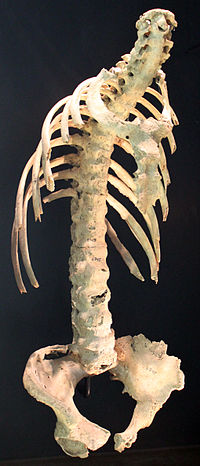
Photo from wikipedia
Objective To evaluate the magnitude of response to secukinumab treatment over 3 years in patients with ankylosing spondylitis (AS) grouped by baseline C-reactive protein (CRP) levels in a pooled study… Click to show full abstract
Objective To evaluate the magnitude of response to secukinumab treatment over 3 years in patients with ankylosing spondylitis (AS) grouped by baseline C-reactive protein (CRP) levels in a pooled study of two pivotal phase III studies: MEASURE 1 (NCT01358175) and MEASURE 2 (NCT01649375). Methods This post hoc analysis pooled data from all patients with available baseline CRP in the two studies who received subcutaneous secukinumab 150 mg (approved dose; N=197) or placebo (N=195). Assessed efficacy endpoints included Assessments of SpondyloArthritis international Society (ASAS)20/40, Bath Ankylosing Spondylitis Disease Activity Index (BASDAI), BASDAI50, AS Disease Activity Score inactive disease and ASAS partial remission among patients grouped by baseline CRP based on central laboratory cut-off <5 mg/L (normal) or ≥5 mg/L (elevated) and a cut-off <10 mg/L or ≥10 mg/L. Results At baseline, 36.5% (143/392) patients had normal and 63.5% (249/392) had elevated CRP. At week 16, ASAS20/40 response rates were higher for secukinumab versus placebo in normal (56.9%/34.7% vs 28.2%/7.0%; p<0.01/p<0.001) and in elevated (63.2%/42.4% vs 29.0%/15.3%; both p<0.0001) CRP groups. Improvement was reported for all outcomes (p<0.05) in both groups, except for ASAS partial remission in the normal CRP group, where a numerical difference 12.5% vs 2.8%, p=0.07) was observed. Similar trends of improvement were observed in the <10 and ≥10 mg/L groups across all efficacy outcomes at week 16. Treatment responses to secukinumab in all CRP groups further improved over 156 weeks. Conclusion Secukinumab 150 mg demonstrated rapid and sustained efficacy in patients with AS irrespective of baseline CRP, with greater magnitude of response in patients with more elevated CRP.
Journal Title: RMD Open
Year Published: 2018
Link to full text (if available)
Share on Social Media: Sign Up to like & get
recommendations!